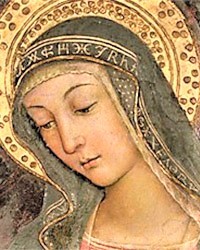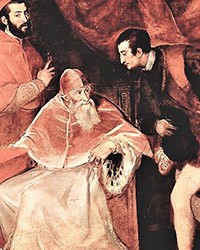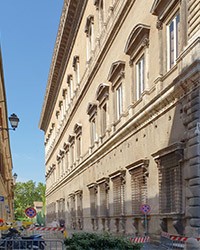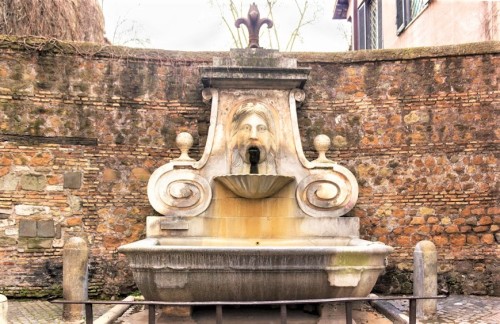
Fountain at via Giulia
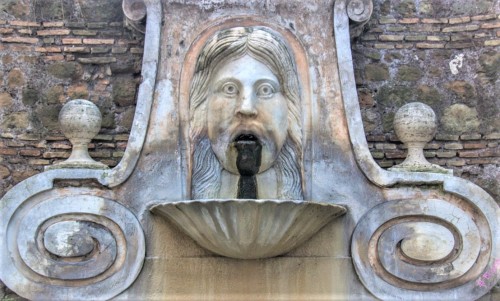
Fontana del Mascherone at via Giulia
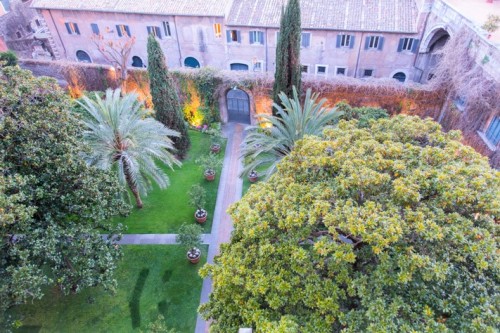
View of the Palazzo Farnese gardens, Fountain del Mascherone at via Giulia (upper left corner)
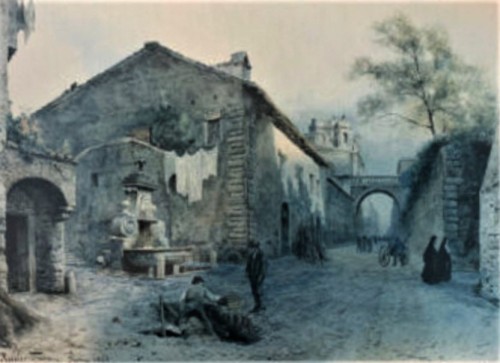
Watercolor from the 19th century showing the original location of the fountain at via Giulia
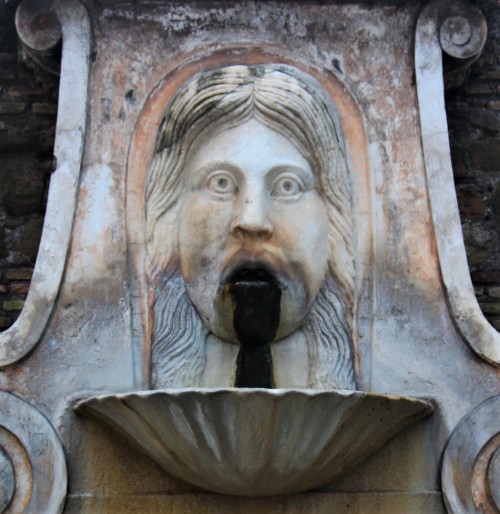
Fontana del Mascherone at via Giulia, fragment
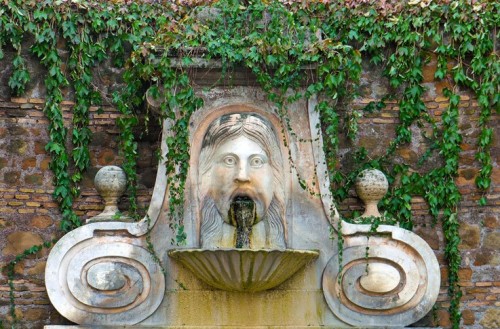
Fontana del Mascherone at via Giulia, fragment
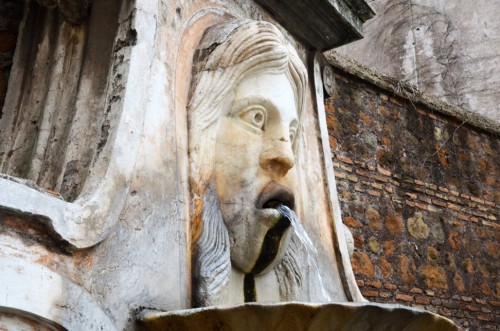
Fontana del Mascherone at via Giulia, fragment
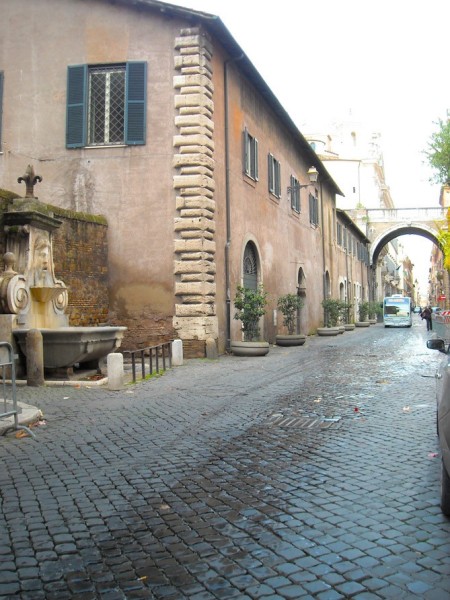
Via Giulia, on the left the fountain of Mascherone
Walking through the picturesque, created during the Renaissance, via Giulia, by via del Mascherone we will come across a beautiful fountain. It has something mysterious in it, but also something poetic. Water flows in it, in a slow-moving stream, and we will not find it in the deep basin, which is the base of the whole construction. However, our attention is drawn to the mascaron adorning it – its unmoving face with mouth agape from which water flows and eyes looking out into the distance.
Walking through the picturesque, created during the Renaissance, via Giulia, by via del Mascherone we will come across a beautiful fountain. It has something mysterious in it, but also something poetic. Water flows in it, in a slow-moving stream, and we will not find it in the deep basin, which is the base of the whole construction. However, our attention is drawn to the mascaron adorning it – its unmoving face with mouth agape from which water flows and eyes looking out into the distance.
As is the case with many other Roman fountains, this one to was created out of ancient elements – a marble mascaron and a porphyry basin, most likely coming from some ancient baths. Only the fleur-de-lis made out of metal, and towering over the whole reminds us that the funders of this structure were the Farnese family which had six such flowers in their coat of arms and whose imposing palace (Palazzo Farnese) is found directly opposite. On the other side of this magnificent family residence, we can see two other fountains funded by the Farneses (the fountains on Piazza Farnese), whose initiator was Girolamo Rainaldi. The same artist most likely also contributed to the creation of the picturesque fountain found on via Giulia, situated here since 1626. His task was not particularly ambitious, he had to combine the ancient elements into one whole, enrich them with the architrave found at the base, which was initially decorated by the fleur-de-lis chiseled out of stone, and adorn the structure with two volutes topped off with spheres. At the base, Rainaldi created a basin, so that the water, which in the past vigorously flowed out of the mascaron’s mouth, filling up the first pool (ancient basin) would enter the one below.
And although a fountain was planned here at the end of the XVI century, the L’ Acqua Vergine aqueduct which was to supply it with water, did not provide it in the appropriate amount. The fountain could only fulfill its function when it was connected to the L’Acqua Paola aqueduct built during the pontificate of Pope Paul V (1612).

The fountain was privately owned as it was located on land belonging to the Farneses however in part – thanks to a decree issued by the pope – it was public in its nature. Initially, it was situated in the center of the small square, which had until 1660 been the site of plays taking place in the open air. In the background waves of the Tiber splashed about and further still a river crossing could be seen with a ferry transporting passengers to both sides. Today the fountain is adjacent to a stone wall, erected in 1903 when after years of trying, the river bed of the Tiber was finally regulated. The wall presently separates via Giulia from Lungotevere dei Tebaldi and undermines the original concept of a picturesque alley.

The fountain gained renown in Rome, not only due to the beauty of the head adorning it but also due to wine that poured out of it from time to time, due to various banquets organized by the Farnese family. Chroniclers report that in 1720 celebrations were taking place on via Giulia due to Marc'Antonio Zondadari receiving the title of Grandmaster of the Order of Malta, and as a result, the street was decorated, while thanks to the generosity of the Farneses, wine poured out of the fountain for three days.
However, let us return to the mascaron adorning the fountain. Such decorations, depicting fantastic, deformed human heads with twisted and bloated lips, were already well-known in ancient Greece and Rome and had again become fashionable in the XVI and XVII centuries. They were used to decorate portals, cornices, and façades of buildings, as well as fountains. The mascaron seen here differs from many of the ones encountered in the city. It is neither terrifying nor ugly as was the case with the remaining ones, and its visage is not deformed by the typical sinister scowl. It is also difficult to say whether it depicts the face of a man or a woman. Its unmoving eyes and the water gently flowing out of its mouth inevitably transport us to the world of ancient beliefs. It is as if we had found ourselves in a place where the earthly world connects with the underworld. Does the water spouting out of the mouth of the stone sculpture not come from the abyss of the world of the dead – Hades or more appropriately the River Styx leading to it? Does the stream flowing out of the mouth frozen in fear not remind us of the crossing which every soul had to make on its way to the underworld? The place had to appear suggestive indeed when the fountain was found close to the sandy shore of a river, out of which the chain of the ferry (Charon’s boat) emerged, enabling passage to the other side – near the Porta Settimiana.






















